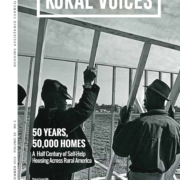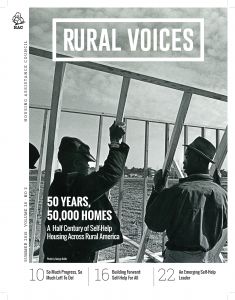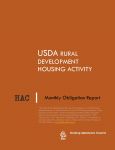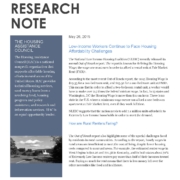HAC News: July 22, 2015
HAC News Formats. pdf
July 22, 2015
Vol. 44, No. 15
• Senate committee passes USDA FY16 spending bill • Small Building Risk Sharing Initiative launched • OMB issues 2015 Circular A-133 compliance supplement • HHUD requests comments on AFFH Assessment Tool • Child poverty persists, 2015 Kids Count data show • “50 Years, 50,000 Homes” celebrated in HAC’s magazine • HAC is hiring for three positions
HAC News Formats. pdf
July 22, 2015
Vol. 44, No. 15
SENATE COMMITTEE PASSES USDA FY16 SPENDING BILL. The Senate Appropriations Committee approved S. 1800 on July 16, with most rural housing program funding at the same levels as the measure passed by the House Appropriations Committee on July 8. Like the House bill, the Senate rejects a cut in Section 523 self-help funding, prohibits early renewal of Rental Assistance contracts that run out of funds before the end of their one-year terms, and does not impose a minimum rent on tenants. The Senate committee’s report says the committee has asked GAO to study maturing multifamily mortgages and to review USDA’s calculations of the amount of RA needed. It encourages USDA to continue its rental preservation efforts and tells the agency its FY17 budget request should show “the true amount needed to renew all expiring rental assistance contracts.” Floor votes have not been scheduled in either chamber. [tdborder][/tdborder]
|
USDA Rural Dev. Prog. |
FY13 |
FY14 |
FY15 |
FY16 House Cmte. Bill |
FY16 Senate Cmte. Bill |
|
|
502 Single Fam. Direct |
$900 |
$900 |
$900 |
$900 |
$900 |
$900 |
|
502 Single Family Guar. |
24,000 |
24,000 |
24,000 |
24,000 |
24,000 |
24,000 |
|
504 VLI Repair Loans |
28 |
26.3 |
26.3 |
26.3 |
26.3 |
26.3 |
|
504 VLI Repair Grants |
29.5 |
28.7 |
28.7 |
26 |
28.7 |
28.7 |
|
515 Rental Hsg. Direct Lns. |
31.3 |
28.4 |
28.4 |
42.3 |
28.4 |
28.4 |
|
514 Farm Labor Hsg. Lns. |
20.8 |
23.9 |
23.6 |
23.9 |
23.9 |
23.6 |
|
516 Farm Labor Hsg. Grts. |
7.1 |
8.3 |
8.3 |
8.3 |
8.3 |
8.3 |
|
521 Rental Assistance |
907.1 |
1,110 |
1,089 |
1,172 |
1,167 |
1,167 |
|
523 Self-Help TA |
30 |
25 |
27.5 |
10 |
27.5 |
27.5 |
|
533 Hsg. Prsrv. Grants |
3.6 |
3.5 |
3.5 |
0 |
3.5 |
3.5 |
|
538 Rental Hsg. Guar. |
150 |
150 |
150 |
200 |
150 |
200 |
|
Rental Prsrv. Demo. (MPR) |
17.8 |
20 |
17 |
19 |
17 |
17 |
|
542 Rural Hsg. Vouchers |
10 |
12.6 |
7 |
15 |
7 |
7 |
|
Rural Cmnty. Dev’t Init. |
6.1 |
6 |
4 |
4 |
4 |
4 |
| a. Figures shown do not include 5% sequester or 2.5% across the board cut. | ||||||
SMALL BUILDING RISK SHARING INITIATIVE LAUNCHED. HUD is implementing an initiative proposed in 2013 (see HAC News, 11/13/13), to facilitate the financing of small multifamily properties through risk sharing. CDFIs, nonprofit lenders, and public and quasi-public agencies can apply at any time for designation as Qualified Participating Entities; for-profit lenders can apply beginning in January 2016. QPEs will underwrite, originate, and service loans for acquisition, refinancing, rehab, and/or equity take outs, but not new construction, up to $3 million (or $5 million in HUD-designated ‘‘High Cost Areas”). HUD will share 50% of the risk. Contact Diana Talios, HUD, 202-402-7125.
OMB ISSUES 2015 CIRCULAR A-133 COMPLIANCE SUPPLEMENT. The supplement will apply to audits of fiscal years beginning after June 30, 2014. Comments are due October 31. Contact a federal awarding agency.
HUD REQUESTS COMMENTS ON AFFH ASSESSMENT TOOL. Jurisdictions will use the tool for assessments required by HUD’s new Affirmatively Furthering Fair Housing rule (see HAC News, 7/8/15). Comments are due August 17. Contact Camille E. Acevedo, HUD, 202-708-1793.
CHILD POVERTY PERSISTS, 2015 KIDS COUNT DATA SHOW. The Annie E. Casey Foundation’s annual research found improvements in child health and education, but the number of U.S. children living in high-poverty neighborhoods is the highest since 1990. One in four children in the U.S. lives in a low-income working family, and economic indicators are lowest for children of color. Data are presented for the U.S. and for each state, county, school district, and congresssional district.
“50 YEARS, 50,000 HOMES” CELEBRATED IN HAC’S MAGAZINE. The latest issue of Rural Voices marks the 50th anniversary of the self-help housing program and recognizes the achievements of the nonprofit sponsors, the USDA programs, and the families who have become successful homeowners. Sign up online to receive email notices when new issues are published.
HAC IS HIRING FOR THREE POSITIONS. HAC seeks a Housing Specialist in Albuquerque, Atlanta, Kansas City, Sacramento, or Washington, DC; a Loan Officer/Underwriter in Washington, DC; and a Development Manager in Washington, DC. Visit HAC’s website for job descriptions and application information.








